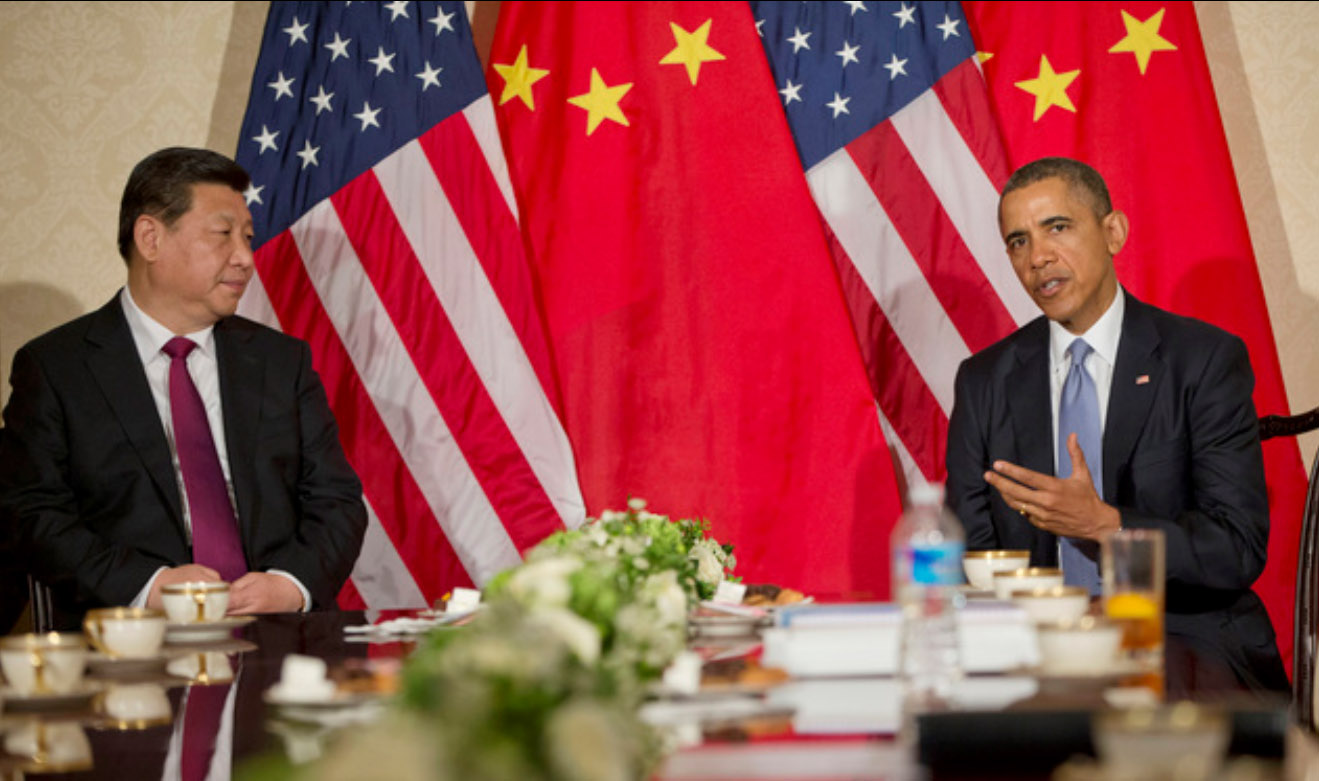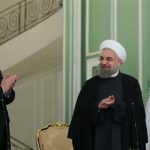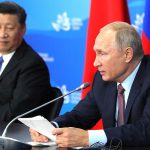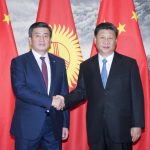by Yu Bin
A specter is haunting the U.S.—a specter of a steadily rising China challenging the US-dominated international economic and security system created 70 years ago at the end of World War II.
At the end of March, 57 nations around the world joined the China-sponsored Asian Infrastructure Investment Bank (AIIB) as its Prospective Founding Member (PFM). Almost all of China’s neighbors signed up, including all 10 members of the Association of Southeast Asian Nations (ASEAN) and all of the member states of the Shanghai Cooperation Organization (SCO). Around the world, 14 members of the G20 group and all of the BRICS nations of emerging economies (Brazil, Russia, India, and South Africa) were on board. Washington was virtually isolated when the G7 European nations (Britain, France, Germany, and Italy) and half of the 28-member European Union rushed in, despite US opposition. The Philippines, which is leading the anti-China crusade in the South China Sea (SCS) dispute, publicly withdrew itself from the US-led and China-excluded talks for the Trans Pacific Trade (TPP) and signed up for AIIB.
No sooner had the AIIB closed its door for PFM than the South China Sea (SCS) issue flared up. Throughout April and May, calls were growing louder inside the Beltway to “punish China” for its island building activities in the disputed SCS and to assert the U.S. freedom of navigation (FON) in the region with US military aircraft and ships. Immediately after US Secretary of State John Kerry’s mid-May visit to Beijing, where he promised the host that Washington was “not taking position on the territorial dispute,” a U.S. Navy P8-A surveillance plane was flying close to several China-held reefs in the SCS, with a CNN camera crew on-board to dramatize the U.S. opposition to China’s operations in the area.
In early June, President Obama joined the choir of alarmists by blaming China for “throwing elbows and pushing people out of the way.” This rather moderate criticism of China, however, was more than offset by the widely publicized U.S. accusation of Chinese spying and cyber-attacks. Philippine President Aquino went as far as to compare China’s stance in the SCS to that of Nazi Germany’s annexation of the Sudetenland in Czechoslovakia before the outbreak of World War II. Meanwhile, Japan is poised to dispatch its powerful navy to the SCS 70 years after it was forced to withdraw on surrendering to the Allies in August 1945. Welcome to the brave new world of speaking loudly and nastily against China while carrying a big stick.
Rise of a Different Power
The U.S. opposition to AIIB and China’s land activities in the SCS, however, is not only misguided, but also demonstrates huge blind spots in the U.S. understanding of China’s strategic culture and historical trajectory.
In the case of the AIIB, China has no intention of challenging the U.S.-dominated international economic system but is reacting to the promised but stalled reform of the IMF to give China and other emerging economies more voting rights, which was proposed in 2010 but has been delayed by the US Congress. China accounts for 17% of global GDP but has only 3.8% of the IMF vote. China’s sponsorship of the AIIB is also driven by the huge infrastructure needs in Asia (up to $8 trillion), which have not been sufficiently addressed by the U.S. and Japan-dominated global financial institutions such as the IMF and Asian Development Bank.
Beyond the AIIB, the rise of China is first and foremost an economic phenomenon. In the past 35 years, China’s GDP growth averages 10% a year, lifting more than 500 million people out of poverty. In 2013, China became the world’s largest trading state with a total trade volume of $4.15 trillion. A year later, China outpaced the United States to become the world’s largest economy in PPP terms ($17.63 trillion verses $17.5 trillion for the U.S.).
The steady rise of China is not only remarkable in economic terms but also has huge implications for the operation of the international system. Instead of imposing itself on the rest of the world and waging endless wars when the West was rising, China’s rise, which is driven by its strategy of peaceful development, is unprecedented in world history, particularly in an age of weapons of mass destruction. In so doing, China so far has no military bases outside its territory, no armed personnel other than those on UN-authorized missions, not a single piece of nuclear weaponry deployed on other countries’ soil, and is the only nuclear-weapon state officially adopting a “no first use” (NFU) policy. In an asymmetrical world of nuclear over-kill capacity, preemption, nuclear first use and trigger-hair alert deployment posture, China’s NFU is the least provocative and represents the shortest distance to nuclear arms reduction and disarmament.
That said, although China’s rise did end the West’s (and Japan’s) domination of China, it does not—and will not—end the West itself. Indeed, most Chinese believe that a strong, stable, and self-confident West, including the United States, is in the interests of China because its wellbeing depends on a peaceful and prosperous world. A deeper philosophical underpinning of China’s current foreign policy can be traced to the Confucian notion of “harmony of differences,” which means that China would live with, but not dominate, others, particularly those nations and peoples with different cultural, historical, political, and economic backgrounds. The reverse, however, may not necessarily be true. It remains to be seen if the U.S., which tends to divide world into friends and foes, would be willing and able to live with a non-Western, non-democratic (of Western style), non-Christian, and non-white China.
SCS: It’s Still History, Stupid?
Given the nature and history of China’s rise, the one-sided and forceful injection of the United States into the SCS dispute is not only unwise but also dangerous in this highly sensitive area with overlapping claims. Washington also ignores, deliberately or not, China’s successful settlement of border disputes with almost all of its neighbors, including land and sea demarcations (the Gulf of Tonkin) with Vietnam. The only remaining border disputes are two sections along the Sino-Indian border, which have been effectively managed since a brief border war more than half a century ago (1962).
For all of the SCS hype, history does seem on China’s side. And Washington is aware of this. On June 1, President Obama himself acknowledged it by saying that some of China’s claims may be legitimate. Other U.S. sources also show that Chinese governments—from the Qing Dynasty of the 19th century to the Nationalist Government in the first half of the 20th century—repeatedly asserted its sovereignty over the SCS region. During the 1884–1885 Sino-French war, China formally objected to France’s efforts to incorporate the SCS islands into French colonized Indochina. China protested again in 1932 when France formally claimed both the Paracel and Spratly Islands. China’s effort to retake these islands from the European colonial powers and Japan received timely and vital help in 1945 when the United States—in accordance with the Cairo and Potsdam Declarations—assisted the armed forces of the Chinese Nationalist government to accept the surrender of the Japanese garrisons in Taiwan, including the Paracel and Spratly Islands.
In comparison to China’s long record of asserting its sovereignty over the SCS, claims by other littoral states such as the Philippines and Vietnam are both late and inconsistent at best. Spain and the United States colonized the Philippines consecutively for four centuries (1543-1946) but never annexed the Spratlys. In 1956 North Vietnam formally accepted that the Paracel and Spratly islands were historically Chinese. The Philippines made its first claims of the Spratlys only in 1972.
Despite its long historical record of sovereignty claims, China physically possesses the fewest islets in the Spratlys (eight compared with 29 by Vietnam and nine by the Philippines) and is the last one to construct runways and other large-scale facilities (Vietnam has constructed 10,000 square meters of facilities in its occupied reefs since 2011). Nor has China resorted to the use of force to retake the reefs in the Spratlys from other claimants but chooses instead to construct those islets it has physically possessed.
China’s land activities in the SCS are also a reaction to a steadily “internationalization” of the SCS dispute since 2009 when the Secretary of State Hillary Clinton declared in a July 2010 speech to the ASEAN Regional Forum (ARF) that FON in the SCS was a U.S. national interest. Meanwhile, the U.S. made clear that its priority is for multilateral negotiations regarding the SCS. That, however, has not entirely neutralized China’s long-standing approach of bilateral talks with other SCS claimants. On October 11, 2011, China and Vietnam signed the agreement of “Basic Principles for the Resolution of Maritime Disputes between China and Vietnam.” In the longer run, China would not easily abandon its claim of the entire SCS represented by the “nine-dash line,” which was officially claimed by the Chinese Nationalist government in 1947 and is still Taiwan’s official policy. Beyond that, however, China will continue to follow its long-held policy of “shelving differences and seeking joint exploration” of the disputed maritime areas with other claimants, which was officially articulated by the late Chinese leader Deng Xiaoping in 1978.
Largely because of China’s restraint, freedom of navigation has never been an issue in the SCS. The reason is simple: perhaps more than any other nation, China, which is the world’s largest trading state, has no interest in obstructing commercial shipping or flights across the SCS. Washington’s insistence on its own FON (by force if necessary), which is not part of the UN Convention on the Law of the Sea (UNCLOS), is pushing the SCS dispute into uncharted waters.
What exactly China will do with those islets in the SCS remains to be seen. History, however, indicates that when China was the strongest power in the world in 1600-1800, it chose to stay in East Asia. When Chinese fleets led by Admiral Zheng He dominated the world’s high seas in the 15th century, they carried porcelain, silk, and other produces as well as goodwill to faraway places, but never attempted to “discover” those places as if nobody lived there. Till today, most of the Chinese do not understand why the rising West since the 18th century did not stay where it was, as China did.
Tale of Two Pivots
Back to the 21st century, the AIIB and SCS issues symbolize two vastly different types of national strategies. In the past 35 years, a steadily rising China has pivoted to the world for trade, investment, infrastructural construction and inter-cultural exchanges. Initiated by President Xi Jinping in 2013, China’s “One Belt One Road” strategy (“Silk Road Economic Belt” and oceangoing “Maritime Silk Road”) aims at integrating the economy of the entire Eurasian continent and beyond.
In contrast, the U.S. has bent to seek its own absolute security, full spectrum dominance, and nuclear primacy. Since the end of the Cold War, the almighty U.S. military—unbalanced and unconstrained in a unipolar world—has pivoted to many parts of the Arab-Islamic world, leaving a trail of bloody wars, untold of human suffering, and failed states now infested with extreme forces such as ISIS. In comparison, the Asia-Pacific region—despite its vastness, diversity, complexity, and lack of an integrated security framework—remains the only region in the world without any major conflict either within or between states. Will this change with direct U.S. intervention in, or “pivot” to, the SCS disputes?
Regardless, U.S. relations with China remain an open-ended issue, which requires patience and wisdom of both sides for a stable and sustainable bilateral relationship for decades to come. China and the U.S. do not need to love each other. Failure to understand each other’s vital interests and strategic culture, however, will lead to outcomes that nobody wants.
Yu Bin is a senior fellow of the Shanghai Association of American Studies.






So the US can deploy heavy military hardware,including the plan to place nuclear missles in Poland, and thats OK, but the Chinese defending their interests becomes an act of aggression. The US has become its own worst enemy.
I’m not really sure what this article is doing on LobeLog. It seems an awful lot like a more nuanced version of the typical ‘People’s Daily-Global Times’ boilerplate about “big bad America” and “nasty old Japan” picking on “harmless and blameless China” and its “totally innocent” little reclamation projects in the South China Sea. Contrary to what the author claims, the sea and its islands and reefs are very much in dispute. Vietnam and the Philippines continue to strenuously protest that China is trying to force them to accept bilateral negotiations favourable to itself, rather than following international maritime law and accepting impartial international mediation to try and solve the disputes.
The Japanese did indeed commit war crimes in Manchuria when they invaded and that shouldn’t ever be forgotten. However, a fact that is conveniently ignored by the Chinese Communist Party and the nationalists whose fervour they seek to stoke with anti-Japanese sentiment, is that the greatest mass murderer of Chinese people, and indeed of any people in history, was Mao Tse-tung. It is estimated that 5-6 million Chinese were directly murdered in the gulags set up and overseen by Mao to consolidate his power, and that up to 70 million more died of starvation due to his political and economic policies. Despite this horrific history, the CCP still reveres Mao and proudly displays his portrait at the site of another government massacre of Chinese people, Tiananmen Square; all while loudly bemoaning the fact Japanese politicians seeking to curry favour with their own nationalists visit the shrines of military commanders who committed some atrocities in China.